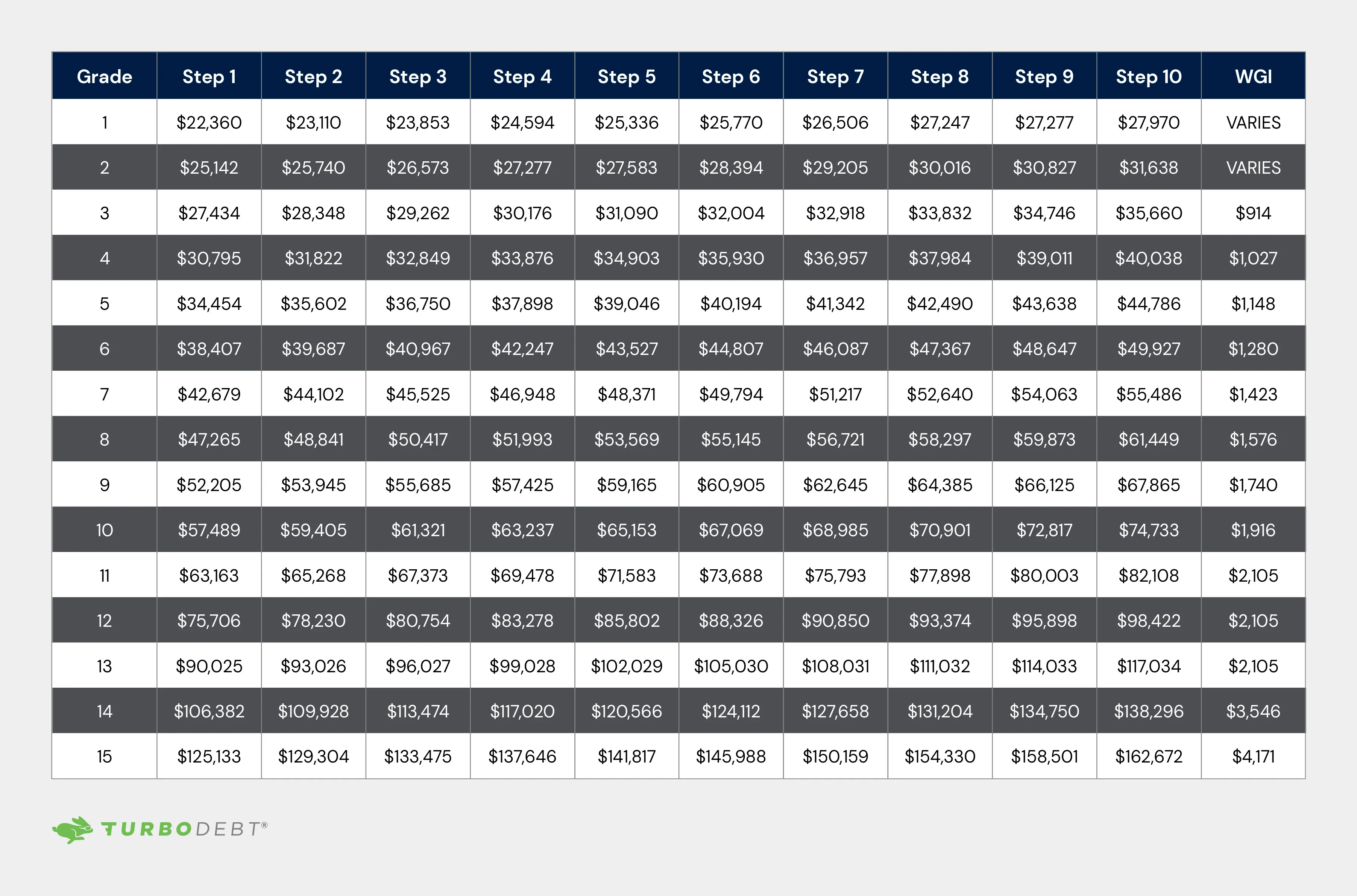Turbo Takeaways
The General Schedule (GS) pay scale is a system that helps determine the salaries of federal employees. The system was established in 1949, and the classification standards, pay structure, and requirements are overseen by the U.S. Office of Personnel Management (OPM).
The GS pay scale is adjusted each year based on the Employment Cost Index (ECI) to ensure federal salaries remain competitive.
This guide explains how the system works, provides a view of the GS pay scale 2025 tables, and explains the structure and pay progression.
2025 Base Rate Salary Chart
Salaries under the GS system consist of a base pay and locality pay adjustment (locality pay tables). The base pay is adjusted depending on the cost of living in different locations. For example, the GS-7 pay scale in 2025 in San Francisco is higher than in Atlanta.
Here’s the GS base rate salary table, effective January 2025:

2025 Hourly Rate Salary Chart
The hourly rate salary chart helps determine the pay for General Schedule employees, paid by the hour. It ensures that federal wages align with similar positions in the private sector. The 2025 hourly rate salary chart is shown below.

How Does the GS Pay Scale Work?
The General Schedule is the primary federal pay scale for white-collar employees in professional, clerical, administrative, or technical positions. The system consists of 15 pay grades, and there are ten steps in each grade.
Grade Levels
The GS pay scale has 15 grades, from GS-1 to GS-15. The higher your grade, the higher your pay can be. For example, a GS-1 employee earns less than a GS-10 employee.
Each agency determines the grade level for every job based on responsibility, required credentials, and level of difficulty.
Steps Within Grades
Each grade level has ten steps, and employees generally advance to the next step based on performance, usually every one to three years. Each step increase typically adds about 3% to the salary.
Advancing from step 1 to step 10 in the same grade usually takes about 18 years, though some employees may qualify for accelerated increases based on exceptional performance.
Grade Level Progress
Federal employees are eligible for pay increases based on performance and time in service. Some positions are designated as “career ladders,” which allow for faster promotion through grades.
For example, a GS-5 to GS-9 career ladder can allow a recent graduate to progress in three years. Since the GS-9 pay scale is significantly higher than GS-5, this can lead to a substantial increase in earnings.
Pay Tables
The U.S. Office of Personnel Management (OPM) oversees the GS pay scale, classifications, policies, and annual adjustments. These tables are updated every year to account for changes in the Employment Cost Index and cost of living.
Each agency categorizes its positions and fills them following the OPM pay regulations. If you’re considering a position with a federal agency, a pay table can help you estimate your gross and net pay.
Locality Pay
GS base pay is adjusted by locality to reflect the cost of living in different regions. This ensures that employees living in expensive GS localities like California will receive higher salaries to compensate for the higher cost of living.
For example, employees in areas like California, Hawaii, and Alaska may receive 10% to 25% higher pay compared to other locations, such as:
- Washington-Baltimore-Arlington: 33.94%
- Rest of U.S. (RUS): 17.06%
- San Francisco-Oakland: 46.34%
- New York-Newark: 36.16%
These percentages are added to base pay to calculate total compensation for federal workers in those areas.
Special Rates and Pay Bands
Some federal positions qualify for special pay rates to help agencies attract top talent. These jobs typically exist in fields like healthcare, cybersecurity, engineering, science, or in remote and hazardous duty locations.
Agencies such as the Internal Revenue Service (IRS), the Environmental Protection Agency (EPA), and NASA may offer these special rates, which OPM approves to remain competitive with private sector salaries.
General Schedule (GS) Grade Levels
The 2025 GS pay scale includes 15 grade levels, each tied to different roles and education levels. Below is a simplified breakdown:
GS-1 — Entry-level jobs like file clerk, cashier
GS-2 — Basic support roles such as library assistant
GS-3 — Administrative aide or park aide
GS-4 — Claims examiner, accounting technician
GS-5 — HR or research assistant (bachelor’s degree)
GS-6 — Logistics coordinator, environmental assistant
GS-7 — Budget analyst, program analyst
GS-8 — IT technician, paralegal
GS-9 — Human resources specialist, compliance analyst
GS-10 — Operations researcher, technical project lead
GS-11 — Economist, grant coordinator
GS-12 — Intelligence analyst, operations lead
GS-13 — Financial manager, senior engineer
GS-14 — Director-level administrator, team supervisor
GS-15 — Senior-level scientific or diplomatic positions
GS Pay Scale Calculator
To estimate your GS pay based on grade, step, and location, you can use an online GS pay calculator. It accounts for your base rate and any locality adjustments to give you a complete salary estimate.
For example, you can use a GS scale calculator to determine GS-14 pay, including locality rates in New York, Washington D.C., or any other GS region in the U.S. for 2025.
Learn About the GS Pay Scale
The GS pay system ensures fair and consistent salaries for federal employees across a range of occupations. Its clear structure allows employees to track compensation and plan for advancement.
If you’d like to learn more about the 2025 GS pay scale or how the system works, it's best to check out the information shared on OPM.gov, the official website of the U.S. Office of Personnel Management.
If you're struggling with credit card debt or personal loans, TurboDebt® may be able to help you find relief. Read nearly 20,000 5-star TurboDebt reviews to see how others are tackling their unsecured debt with expert support.
Contact TurboDebt today for a free consultation. It only takes a few minutes to discover if you qualify for debt relief services and find out more about your options.
